The Nobel Prize in Physics in 2017, predictably, went to Kip Thorn, Reiner Weiss, and Berry Berish for the experimental detection of gravitational waves on LIGO laser interferometric instruments. This success (and the detection of gravitational waves (GW) from two merging black holes for the first time occurred on September 14, 2015) was the fruit of an approximately 50-year development of the technology for detecting GW. As a result of this development, the LIGO tool has chilling characteristics, however, no human epithets convey the level of precision of this machine.
 Laser interferometric gravitational observatory LIGO in Livingstone, Louisiana, USA.
Laser interferometric gravitational observatory LIGO in Livingstone, Louisiana, USA.Today we will talk about the engineering device LIGO. But before - about gravitational waves in general.
Gravitational wave radiates any matter moving with asymmetric acceleration. For the appearance of a wave of substantial amplitude, an extremely large mass of the radiator and / or huge accelerations are necessary, since the amplitude of the gravitational wave is directly proportional to the first derivative of the acceleration and the mass of the generator. Some significant GW radiation powers are mainly obtained from merging black holes and neutron stars, as well as during asymmetric supernova explosions, while the ideal option is a pair of black holes orbiting around each other in a very close orbit. For rotating pairs, the frequency of the emitted gravitational waves is equal to twice the frequency of revolution of the two-body system. Frequencies from hertz fractions to hundreds of hertz, which means wavelengths from hundreds to millions of kilometers, are characteristic of the most frequently occurring events in the Universe, accompanied by the emission of GW.
Simulation of radiation of gravitational waves by a merging pair of black holes.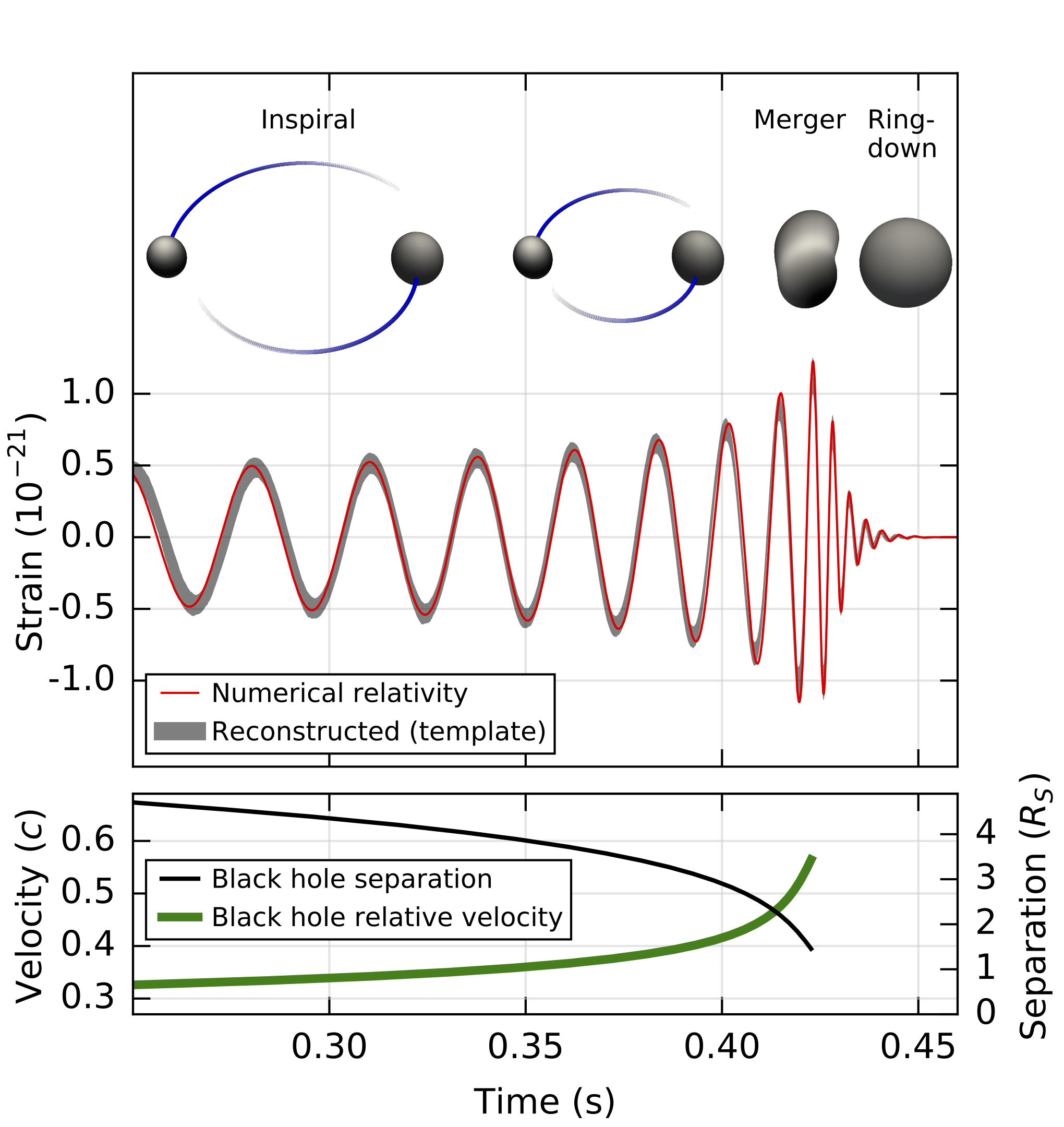 A characteristic pattern from two merging black holes - the orbit quickly decreases due to the radiation of the rotational moment in the form of gravitational waves and finally they merge, leaving a “post-sound” - resetting form distortions in the form of gravitational waves.
A characteristic pattern from two merging black holes - the orbit quickly decreases due to the radiation of the rotational moment in the form of gravitational waves and finally they merge, leaving a “post-sound” - resetting form distortions in the form of gravitational waves.Gravitational-wave astronomy is a long-time object of desire of specialists. It allows you to study objects that weakly manifest themselves in electromagnetic radiation, and therefore inaccessible to modern astronomy. For details, I advise you to read "
Gravitational-wave sky "
How can you detect a gravitational wave? Unfortunately, there are no easy ways to do this. In LIGO, the property of gravitational waves is used to periodically change the distances between two test masses (and the test masses are the key detector here), but these changes are very small. If we move apart the two test masses, say, by kilometer, then all that we will see is the fluctuation of the distance between them with an amplitude of ~ 10
-21 , i.e. about 1/10000 the size of a proton, and one billionth the size of the electron shell of an atom. If you increase the line to a million kilometers, the situation does not drastically improve (even if you stretch the line to Pluto, then its accuracy should be in the area of nanometers).
 Deviation of test masses (black squares) during the passage of a gravitational wave from its initial positions (empty squares).
Deviation of test masses (black squares) during the passage of a gravitational wave from its initial positions (empty squares).However, if you go from the material lines to the light, then you can make some progress. The Michelson interferometer uses destructive interference (i.e., damping of two waves in antiphase) transmitted through two measuring arms. If the length of the arms ceases to be equal, then light begins to appear on the detector, and for ideal, non-quantum light, we can measure in this way any amount of displacement of the mirrors.
 The principle of the influence of the passing HW on the Michelson interferometer and the occurrence of a signal when the shoulder sizes are unbalanced.
The principle of the influence of the passing HW on the Michelson interferometer and the occurrence of a signal when the shoulder sizes are unbalanced.In practice, laboratory interferometers measure changes in the distance of tens of nanometers without any problems, and advanced devices measure fractions of nanometers. Even if you make an interferometer with shoulders ~ 4 km (and this is the optimal length for the noise budget, which we will discuss later) with an accuracy of 0.1 nm, then this is only ~ 10
-14 - i.e. still 10 million times less sensitive than necessary!
The use of Fabry-Perot optical resonators helps to reach the
Nobel Prize of necessary precision even in theory. The insertion of such a resonator into the long measuring arm of the interferometer causes the light to be repeatedly reflected between two mirrors applied to the test masses. In fact, this extends the effective length of the interferometer several hundred times (for LIGO, this value is about 300). Further, this trick is repeated by inserting reflectors into the input and output of the interferometer — photons that pop up from the resonators in the long arms repeatedly reflect back and gradually gain the technically measured path difference of the rays.
 Schematic diagram of LIGO: ETM - external test masses, ITM - internal, together they form a resonator. CP - thermocompensating plates, BS - beam divider. PRM and SRM are systems for recycling the original photons and photons of the useful signal, PD is a photodiode, GW readout is a system for reading the signal of gravitational waves.
Schematic diagram of LIGO: ETM - external test masses, ITM - internal, together they form a resonator. CP - thermocompensating plates, BS - beam divider. PRM and SRM are systems for recycling the original photons and photons of the useful signal, PD is a photodiode, GW readout is a system for reading the signal of gravitational waves.However, between the idea and the implementation in this case lies the abyss. Taking a measuring instrument of such precision in your hands, you will discover dozens of noise sources that are thousands and millions of times greater than the useful signal. However, speaking of millions, I too underestimate. Seismic oscillations in amplitude exceed the GW signal by 11 orders of magnitude (ie, 100 billion times).
 Vibration of mirrors without damping, reduced to the measured characteristic (distance between test masses) at the LIGO installation site.
Vibration of mirrors without damping, reduced to the measured characteristic (distance between test masses) at the LIGO installation site.The fight against these noises is an incredible engineering-physical saga that has spread over decades. Talking about this fight, it is convenient to bring everything into the system in which the useful signal is recorded - i.e. in the form of the oscillation amplitude of the shoulder of the interferometer, comparing it with the cherished sensitivity of 10
-21 .
 The pipes of the vacuum system have a diameter of 1.24 meters; in particular, the LIGO Hanford corner (central) station is shown here. 4 km measuring shoulder goes to the right.
The pipes of the vacuum system have a diameter of 1.24 meters; in particular, the LIGO Hanford corner (central) station is shown here. 4 km measuring shoulder goes to the right.The first engineering miracle on which LIGO is based is the vacuum system. The volume of the optical system undergoing vacuuming is very large - about 10 thousand meters
3 , while the vacuum level is 10
-9 Torr (~ 10
-7 Pa - this vacuum is steeper than in
the ITER vacuum chamber ). Vacuum is needed, first of all, to isolate equipment from acoustic vibrations, and secondly, in order to get rid of random distortion of the laser beam phase on gas molecules, which would give an unnecessary noise on the receiving detector. Before prototyping vacuum volumes of LIGO, it was not even clear whether such a vacuum could be sustained in such a volume — no one had achieved this before LIGO. For pumping, a set of mechanical forevacuum pumps, turbo-molecular pumps, cryovolves and ion pumps is used. In total, the achievement of a working vacuum with intermediate annealing in LIGO takes 40 days.
 Post measurement of the quality of the vacuum and the composition of the residual gases in the composition of the LIGO.
Post measurement of the quality of the vacuum and the composition of the residual gases in the composition of the LIGO.Inside the vacuum system are the main components - ETM end test masses (“long” shoulder mirrors), ITM internal test masses, BS beam divider, input beam regeneration chamber and PRC and SRC signal output, spatial mode cleaning systems (about mods further) laser radiation . At the same time, the main laser itself is located outside, on a practically ordinary laboratory optical table.
Speaking about LIGO lasers, it should be noted that in the same optical system two coexist at once - the main superstable laser with a wavelength of 1064 nm and an auxiliary laser with a wavelength of 532. The latter is used to measure the distance between the mirrors and the active correction of the position of the optics needed to enter Fabry-Perot resonators in the mode of conservation of light.
 The main 200-watt measuring laser LIGO (installed in 2010, before that was a much less powerful laser). The black pyramid on the right is the periscope sending a laser beam to the interferometer.
The main 200-watt measuring laser LIGO (installed in 2010, before that was a much less powerful laser). The black pyramid on the right is the periscope sending a laser beam to the interferometer.The main 1064 nm laser is located on a conventional optical table and is an ultra-stable in frequency and amplitude (10
-7 and 10
-9, respectively) laser with a power of 220 watts on the table and 180 watts after the mod cleaning system. The modes are longitudinal and transverse standing waves arising in a laser beam, and so - for LIGO you need a laser beam with only the main TEM00 mode, i.e. where is actually a spatially completely homogeneous beam.
 Detailed image of the output part of the laser, which includes a dependent beam amplifier from 35 to 220 W, a diagnostic assembly, a PMC mod pre-cleaner, and an exemplary resonator for tuning the laser frequency.
Detailed image of the output part of the laser, which includes a dependent beam amplifier from 35 to 220 W, a diagnostic assembly, a PMC mod pre-cleaner, and an exemplary resonator for tuning the laser frequency.By the way, pay attention to power. 200-watt permanent lasers are more likely to be associated with sharp materials than with thin physical experiments. However, in the case of LIGO, the accuracy of determining the coordinates of the mirrors increases as the root of the laser power, therefore, the captured power of hundreds of kilowatts of laser light runs in the arms of the interferometer (planned - up to 830 kW!). The negative effect from the crazy power is the distortion of the optics from heating - and this is in a laser system with the highest requirements in the world. But we'll talk more about that.
 To obtain a stable seed frequency, a special non-planar laser resonator is used — the planar laser frequency is too dependent on the distance between the end mirrors, which vary due to the temperature expansion of the crystal.
To obtain a stable seed frequency, a special non-planar laser resonator is used — the planar laser frequency is too dependent on the distance between the end mirrors, which vary due to the temperature expansion of the crystal.The generated laser beam is fed into the vacuum system, where it passes the input cleaner of the spatial modes, the resonator recirculates the input power and through the beam divider enters the measurement arms. As the system passes, requirements for the immobility of mirrors grow, because their movements from vibrations can be taken as a signal from a gravitational wave!
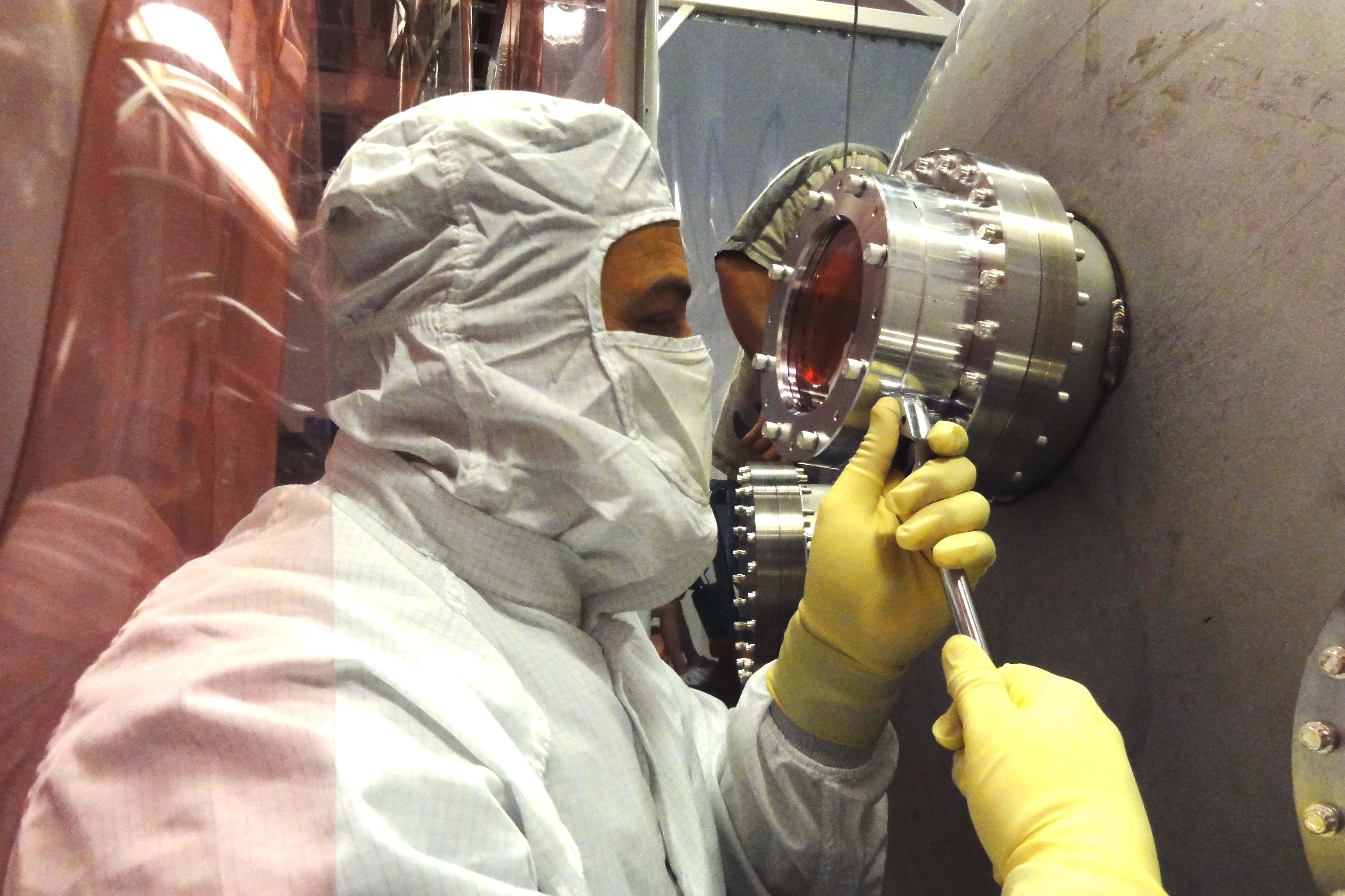 Through such a port, the radiation is brought inside the vacuum system.
Through such a port, the radiation is brought inside the vacuum system.In numbers, it looks like this - in the range of maximum sensitivity of the interferometer (from 30 to 600 Hz) the amplitude of the noise oscillations of the mirrors should be from 10
-13 m to 10
-19 m. Moreover, the normal level of vibrations of such mirrors without any systems suppression in the places of construction of interferometers (Hanford and Livingston) is from ~ 10
-10 meters. The difference of 9 orders between “is” and “need” is so great that it took about 30 years of development and research to overcome it.
 The appearance of the test mass suspension is misleading: the metal frame is here for auxiliary elements, it does not hold the test mass itself (the pink disk is below)
The appearance of the test mass suspension is misleading: the metal frame is here for auxiliary elements, it does not hold the test mass itself (the pink disk is below)The creators of LIGO say that without its fantastic suspension-damping suspension, the interferometer can fix cyclists in kilometers from the setup, feel the tremor from the surf in thousands of kilometers, moreover - LIGO is sensitive to movement of air masses causing oscillations of the gravitational field (!).
In the creation of suspensions that weaken the impact of the environment by 10 orders of magnitude, 3 approaches were used. The first, classic - is the creation of the most rigid structures of the first stages of the suspension, which minimizes the amplitude of vibrations. The second approach is also known to fighters with vibration - these are active compensation systems that move the platform in the opposite direction to vibration, which allows the amplitude of vibrations to be reduced by a factor of 1000. Finally, and in this unique solution LIGO is the use of the last stages (ETM / ITM suspension has 7 stages of vibration suppression) of the pendulums.
 The active isolation is the latest version of LIGO (on the right) - precision hydraulic drives of the vacuum chamber, two-stage active (with electric drives) vibration suppressor and 4-step pendulum.
The active isolation is the latest version of LIGO (on the right) - precision hydraulic drives of the vacuum chamber, two-stage active (with electric drives) vibration suppressor and 4-step pendulum. Scheme pendulum suspension.
Scheme pendulum suspension.It would seem that the pendulum is the last thing that is needed to minimize the swinging of the optics. However, a clever trick is used here, namely, ultrahigh-quality pendulums, the natural frequency of which is derived from the operating range (they swing more slowly than the minimum frequency of gravitational waves, which is monitored by LIGO). This means that any vibration action will be transferred to the natural frequency of the pendulum oscillation and attenuated very strongly at other frequencies.
 The degree of vibration suppression of the active part (blue line), the pendulum (green), and the total (red).
The degree of vibration suppression of the active part (blue line), the pendulum (green), and the total (red).After a significant attenuation of vibrations and active compensation of slow “geological” vibrations, the thermal system noise becomes the main source of noise. Atomic thermal vibrations are easy to ignore, as long as you are not trying to measure something a thousand times smaller than these atoms.
In the fight against thermal oscillations (in the course of the research, a fundamentally new thermally oscillating phenomenon was discovered) the same approach is used - test masses are highly homogeneous cylinders made of fused silica, polished on all sides to a roughness of 1 nm, which creates a high-quality “tuning fork”, their own whose frequencies lie outside the measurement band of the resonator. Nevertheless, Brownian particle motion in the reflective coating of ITM / ETM mirrors is one of the dominant sources of noise in LIGO.
 The budget for the contribution of different types of noise to the overall sensitivity of LIGO (calculated values). In general, the sensitivity is mainly determined by the quantum limit (violet line) and in the range of 50-100 Hz - the thermal noise of the coating (red line).
The budget for the contribution of different types of noise to the overall sensitivity of LIGO (calculated values). In general, the sensitivity is mainly determined by the quantum limit (violet line) and in the range of 50-100 Hz - the thermal noise of the coating (red line).Interestingly, one of the noise control areas turned out to be threads on which test masses are suspended. Thermoelastic noises that arise from the interrelation of temperature and Hooke's module walk in them. To minimize this phenomenon, we had to use thin quartz threads (0.4 mm) and attach them as smoothly as possible to the quartz test mass (this was done at the University of Glasgow, and the theory of all these moments was developed at the Physical Faculty of Moscow State University). Interestingly, the time of calm (energy dissipation) of this pendulum in vacuum exceeds 10 years.
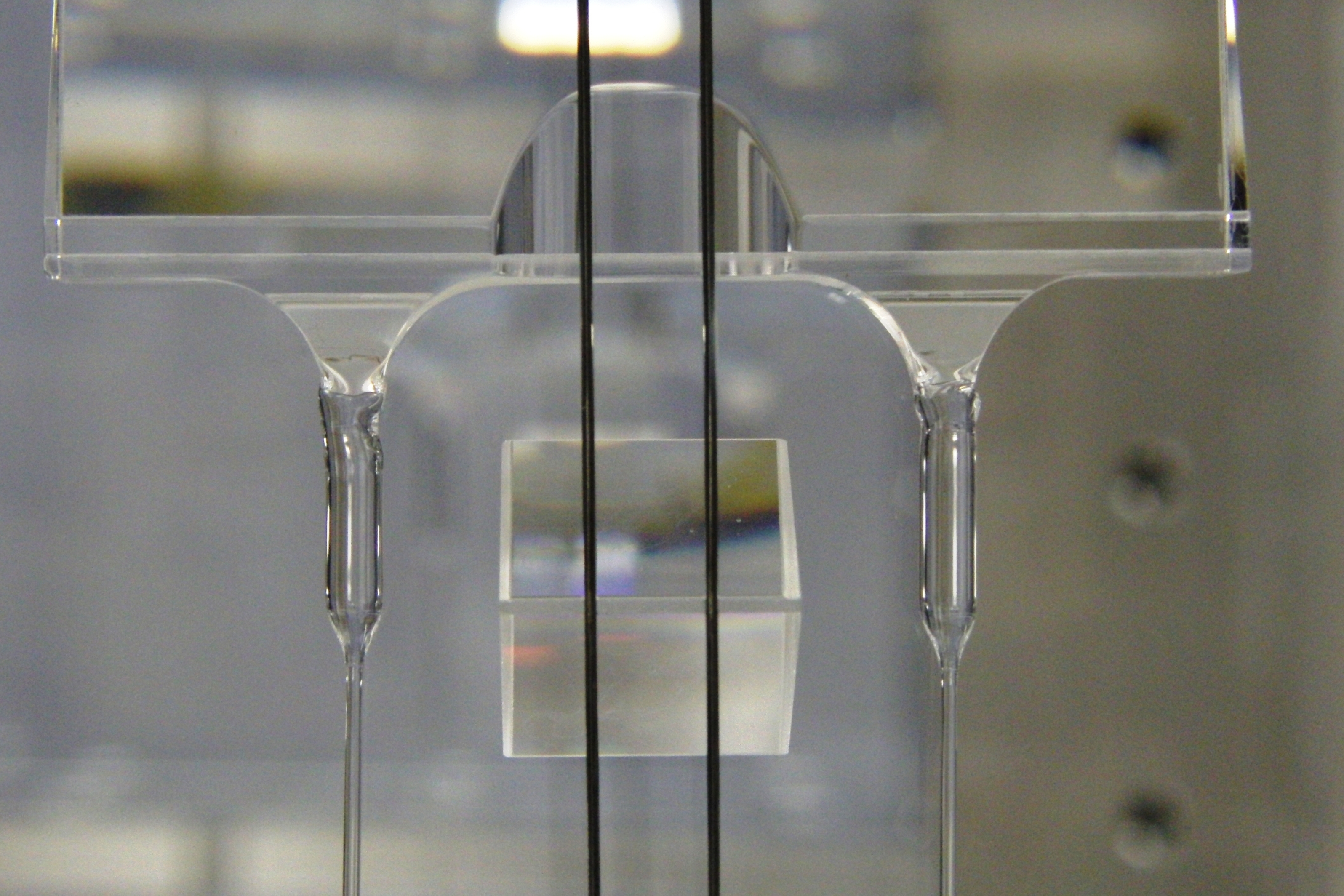 Welding of quartz filaments to the pendulum mass.
Welding of quartz filaments to the pendulum mass.Of course, as part of this battle for precision, ITM / ETM mirrors have a record surface smoothness — using “ion milling”, their substrate was brought to a roughness of 0.08 nm — that is, to a fundamental limit due to the size of the silica molecules. Such smoothness and 40-layer reflective coatings led to record characteristics of the mirrors - the loss of light from the reflection between ITM and ETM is only 50 ppm (ie, 0.005%!). This moment was fundamentally important for the construction of LIGO, both in terms of the maximum quality factor of optical resonators, and in the sense of maximum uniformity of the shoulders, including minimal difference in the loss of light in them.
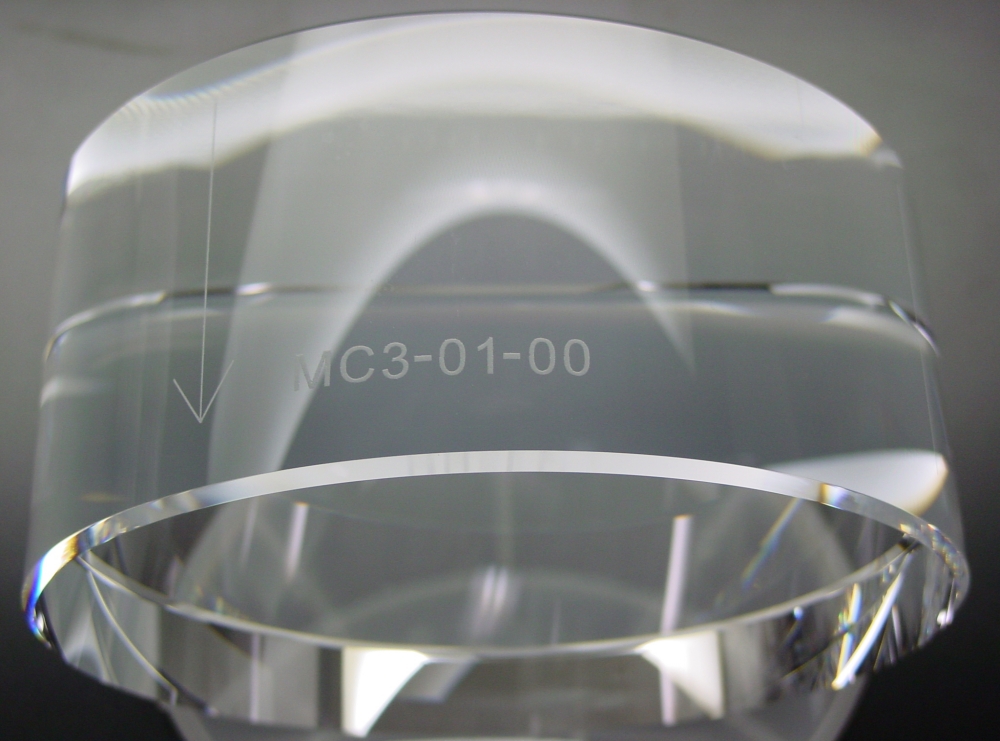 One of the mirrors of the PRM power recirculation system. By the way, at a glance, this optics is almost transparent - super-mirror coatings work only in a narrow frequency range around IR laser radiation.
One of the mirrors of the PRM power recirculation system. By the way, at a glance, this optics is almost transparent - super-mirror coatings work only in a narrow frequency range around IR laser radiation.Another interesting aspect of the test mass suspension is that the mirrors here must be active - i.e. put up in the required positions with an accuracy of tens of picometers to capture light by Fabry-Perot resonators. But how to do it for a mirror that:
a) must be a measuring mass not related to anything
b) damped by 12 order from any vibrations?
The answer lies in dividing the mirror into 2 components, one of which is the test mass, and the second is the reactive mass. Both masses are equally damped from vibrations, and the distance between them is regulated by an electrostatic drive. By the way, in order for the charge fluctuations and, accordingly, the electrostatic drive forces not to interfere with the measurements, we had to get rid of the close-standing ion vacuum pump, the ions of which reduced the charge of the test mass.
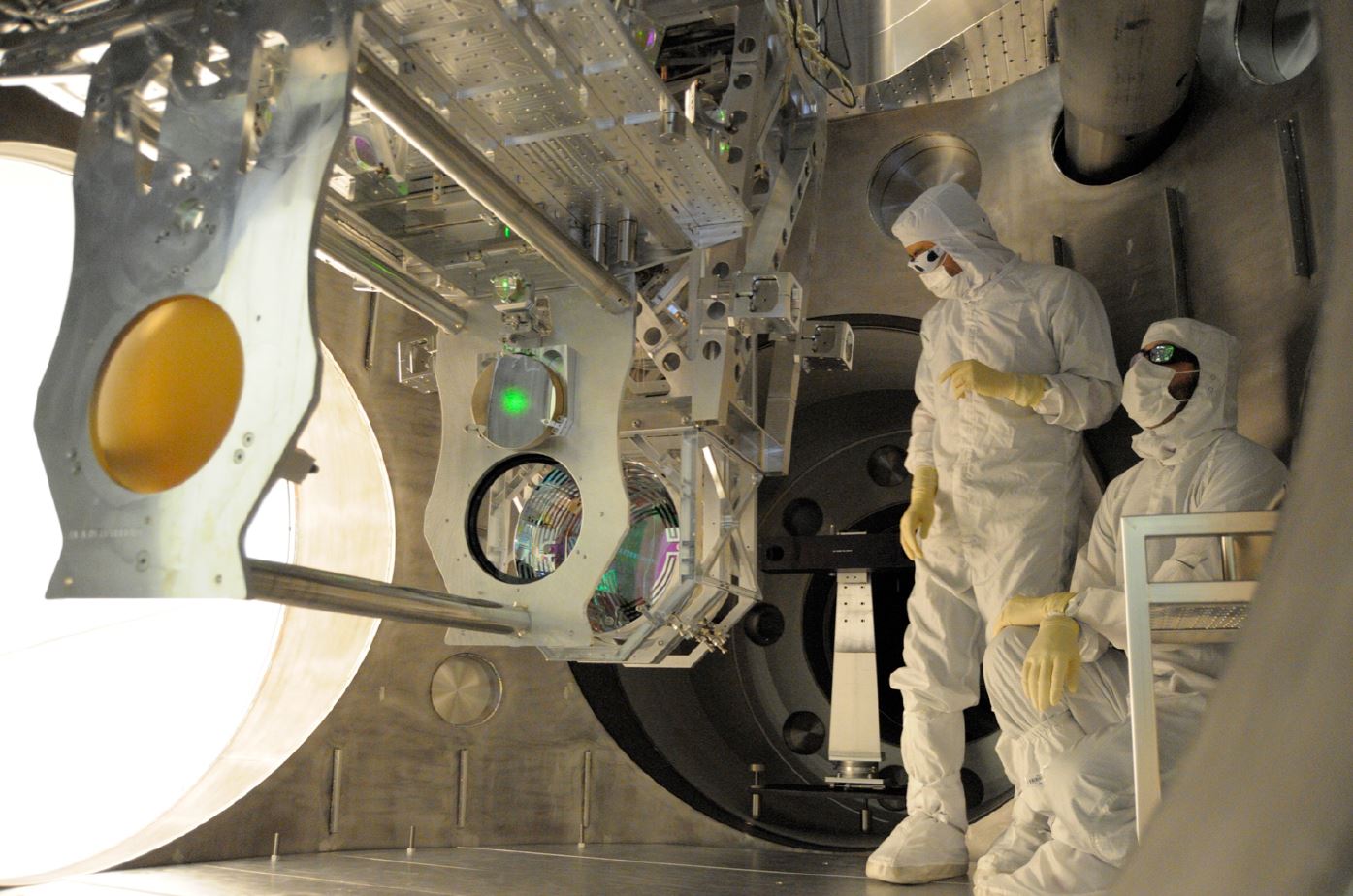 On the test mass below are visible concentric electrodes of the electrostatic actuator. The protective films from the optics have been removed, the spot (green) of the measuring interferometer is visible - these are the last stages of the adLIGO setup before evacuation.
On the test mass below are visible concentric electrodes of the electrostatic actuator. The protective films from the optics have been removed, the spot (green) of the measuring interferometer is visible - these are the last stages of the adLIGO setup before evacuation.Continuing the topic of noise, you need to tell about thermal compensation optics. The laser beam, especially in Fabry-Perot resonators, where its power according to the project reaches 830 kW, even with minimal absorption heats the quartz, causing distortion of the shape of the mirrors. Usually in optics they are struggling with this by means of forced cooling, but in this case, in vacuum and on a super suspension, it is obviously impossible to do this. In LIGO used a non-trivial solution - to heat the rest of the mirror to the same temperature. For this purpose, rotating projectors with CO2 laser are used, which heat on special plates inserted between the main elements of the annular zone around the measuring beam, thereby compensating for shape distortion.
 The key element of the interferometer is the beam divider.
The key element of the interferometer is the beam divider.One of the most amazing system noises is the so-called “Newtonian”. It is associated with a change in the gravitational field under the influence of lunar and solar tides, the movement of mantle masses, atmospheric areas with higher or lower pressure.
Small changes in gravity excite slow vibrations in the crust that LIGO feels. For detuning from this noise, an entire system of gravimeters, pressure sensors, temperature and microphones is built up, which gives data to the input of the inter-autometer auto-tuning system, which tries to compensate for these effects. Nevertheless, at frequencies below 10 Hz, the amplitude of these effects begins to dominate in the noise pattern, forming a so-called. seismic wall. In fact, this means that it is impossible to build a detector of low-frequency gravitational waves on earth, which are typical, for example, of coalescing super-large black holes (galactic nuclei). For this cosmology, interferometric space-based HB observatories will be needed.
 Historical first recorded case of detection of a gravitational-wave event of 09/14/2015 - even before the official start of the first session of the improved LIGO. It can be seen that in the amplitude values the peak of the GW is only twice as large as the amplitude of the noise, but in the spectral decomposition of the GW it can be seen very well.
Historical first recorded case of detection of a gravitational-wave event of 09/14/2015 - even before the official start of the first session of the improved LIGO. It can be seen that in the amplitude values the peak of the GW is only twice as large as the amplitude of the noise, but in the spectral decomposition of the GW it can be seen very well. Today, LIGO recorded 5 events with a high level of reliability and one candidate (LVT151012) during 3 sessions of scientific work, which is probably just noise. The first four recorded events are quite distant fusions of black holes, although initially the instrument was designed to search for merging neutron stars at a distance of up to 200 megaparsecs.
Today, LIGO recorded 5 events with a high level of reliability and one candidate (LVT151012) during 3 sessions of scientific work, which is probably just noise. The first four recorded events are quite distant fusions of black holes, although initially the instrument was designed to search for merging neutron stars at a distance of up to 200 megaparsecs.In the course of about 30 years of improving laser-interferometric technologies (including LIGO themselves underwent 2 upgrades in the early 2000s and early 2010s), physicists came very close to the new measurement accuracy limit,
quantum, for installations. At virtually all frequencies, the quantum limit arising from the Heisenberg uncertainty principle determines the sensitivity of the machine.
Although there are several ways to slightly push it away (by using “squeezed light” and increasing the weight of the test masses), on the whole, there are no ways to increase the sensitivity of ground-based laser interferometers above about 10-25.You can learn more about LIGO and the quantum limit from the reports at the HEA-2016 conference on this video.But such sensitivity will be a very interesting result. LIGO, working in 2014–2017 at a sensitivity of about 10–22, catches about 1 gravitational wave event per year. However, the detection of HS has a very pleasant property - we detect amplitude, not power, as in the electromagnetic spectrum. The amplitude of any waves falls linearly depending on the distance to the source, which means that an increase in sensitivity only 2 times increases the observed volume per cube from 2 - i.e. 8 times. Approximately 8 times the number of sources of gravitational waves, and the frequency of events grows.Increasing the sensitivity by 1.5-2 orders of magnitude can lead to the fact that GW events will be recorded several times per hour. Europe also has its own VIRGO laser interferometric observatory located in Italy. Similar installations are also being built in India (where one instance of LIGO was transferred) and in Japan.However, for today (autumn 2017), LIGO has not yet reached even the planned sensitivity limit of 10-23 , mainly due to the difficulties of raising the power of the radiation captured by the shoulders to the planned value of 830 kilowatts. For example, glare from structural elements back into the optical system turned out to be a big problem — although the relative power seems to be small, the parasitic glare reflects from unstabilized elements and carries a level of vibrations 12 orders higher than the level in the main beam.
Europe also has its own VIRGO laser interferometric observatory located in Italy. Similar installations are also being built in India (where one instance of LIGO was transferred) and in Japan.However, for today (autumn 2017), LIGO has not yet reached even the planned sensitivity limit of 10-23 , mainly due to the difficulties of raising the power of the radiation captured by the shoulders to the planned value of 830 kilowatts. For example, glare from structural elements back into the optical system turned out to be a big problem — although the relative power seems to be small, the parasitic glare reflects from unstabilized elements and carries a level of vibrations 12 orders higher than the level in the main beam.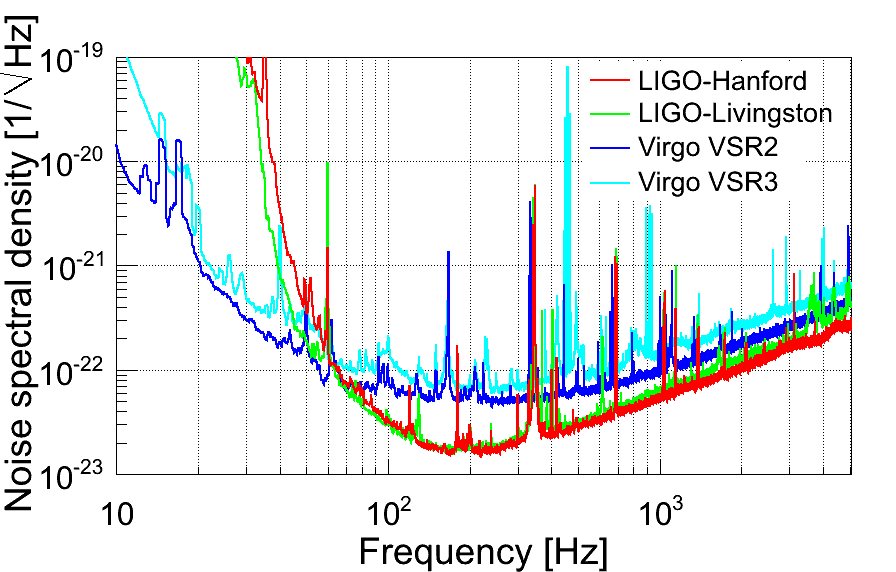 The sensitivity achieved so far is slightly worse than 10 -23and about 4-5 * 10 -23 in a wide frequency range. VIRGO so far has a sensitivity several times worse.In any case, September 2015 marked the beginning of a new type of astronomy, which will most likely tell a lot about the Universe (for example, the frequency of collisions of intermediate-mass black holes has already become unexpected for astronomers - no one suspected that there are so many BHs). Another interesting result of the LIGO program is that the scientific result can be the fruit of decades of work, and it is not worth doing extrapolations in the spirit of "have not received in 20 years - they will never get."PS A beautiful story about people and ideas on the way to the discovery of gravitational waves from Igor Ivanov.PPS Literally at the same time With this publication, a collaboration of astronomers from around the world announced the detection of a merger of two neutron stars using gravitational-wave detectors, as well as several telescopes (optical, gamma, and X-ray).
The sensitivity achieved so far is slightly worse than 10 -23and about 4-5 * 10 -23 in a wide frequency range. VIRGO so far has a sensitivity several times worse.In any case, September 2015 marked the beginning of a new type of astronomy, which will most likely tell a lot about the Universe (for example, the frequency of collisions of intermediate-mass black holes has already become unexpected for astronomers - no one suspected that there are so many BHs). Another interesting result of the LIGO program is that the scientific result can be the fruit of decades of work, and it is not worth doing extrapolations in the spirit of "have not received in 20 years - they will never get."PS A beautiful story about people and ideas on the way to the discovery of gravitational waves from Igor Ivanov.PPS Literally at the same time With this publication, a collaboration of astronomers from around the world announced the detection of a merger of two neutron stars using gravitational-wave detectors, as well as several telescopes (optical, gamma, and X-ray).